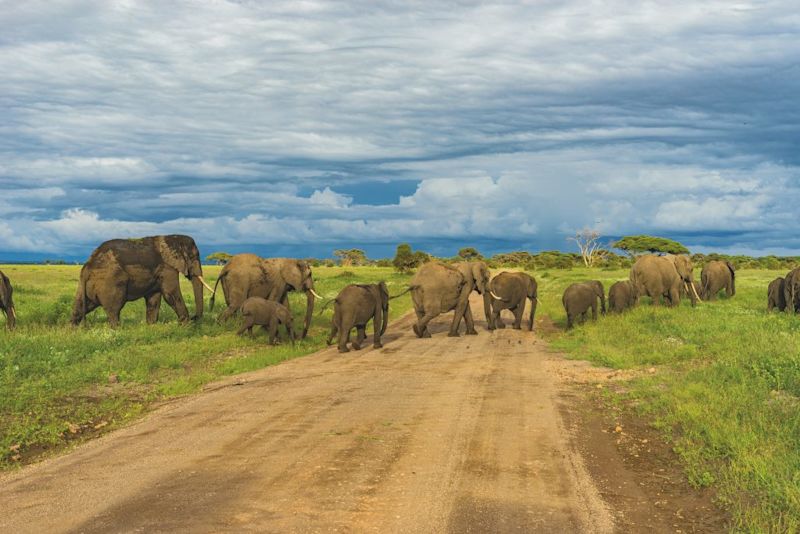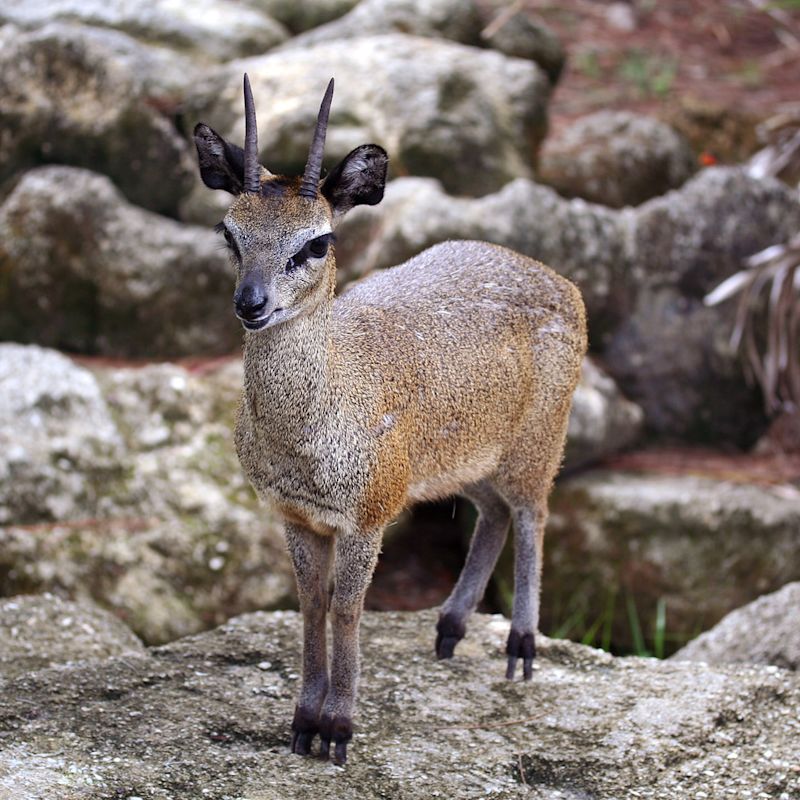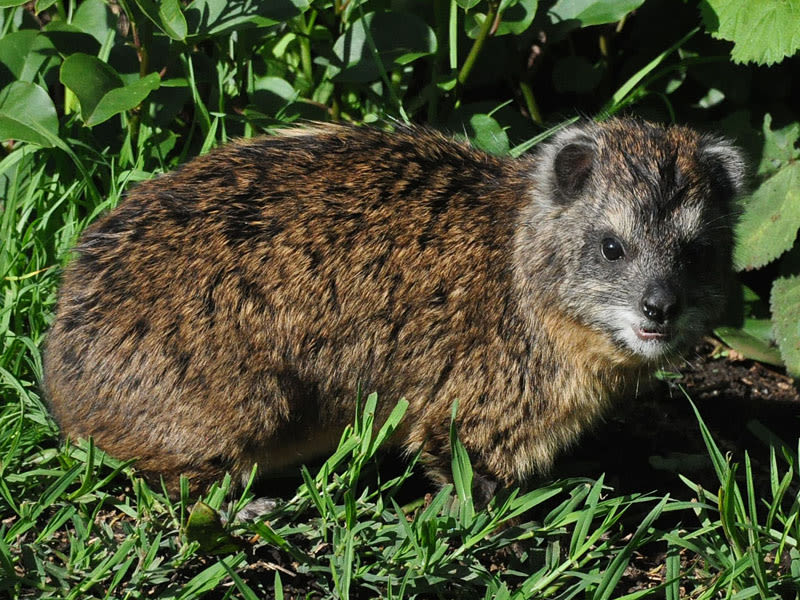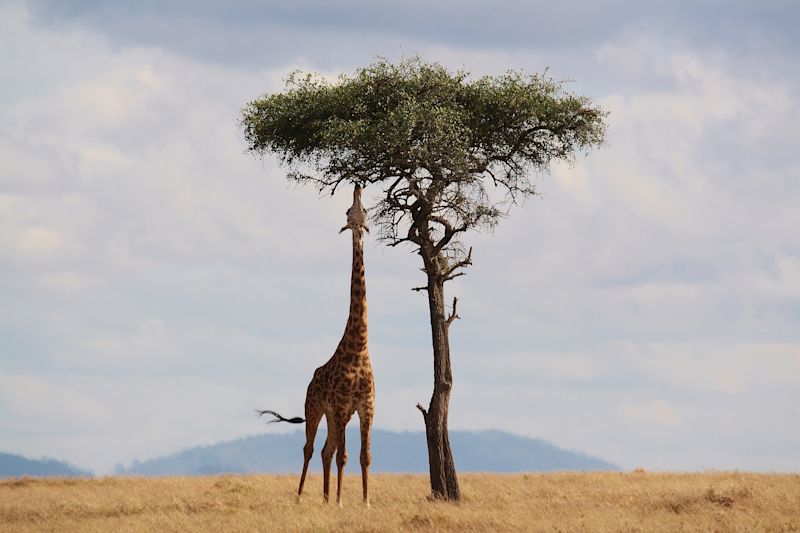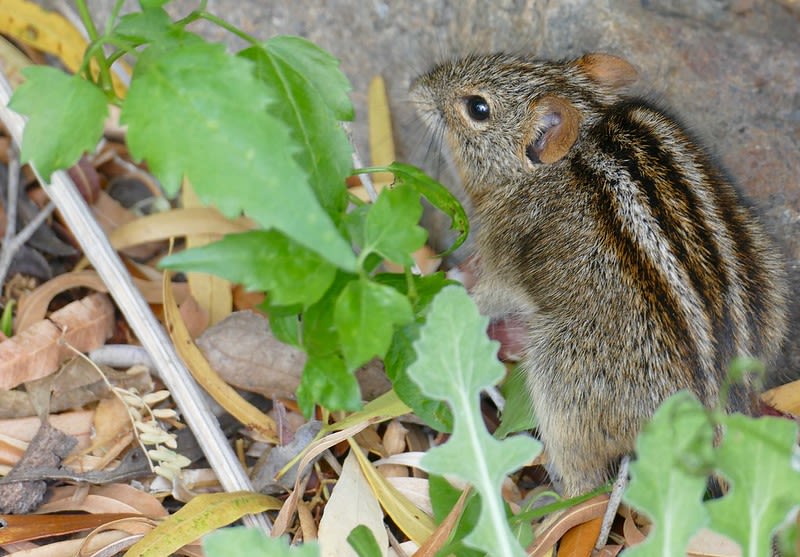Most people heading to Kilimanjaro National Park are going there to climb the mountain, with game spotting not the primary focus. But whether you're heading there for a climb or a safari, there are many fascinating and rare animals on Kilimanjaro, and we are pleased to introduce you to them below!
But just a note: if you really want to see large African mammals like the Big Five, we recommend going on a Tanzania safari in one of the other major national parks in the region (like Ngorongoro Crater or the Serengeti). There you'll see enormous game, predators aplenty, and even the Great Wildlife Migration.
Baboons live on the lower slopes of Kilimanjaro
A wonderful diversity of animals
Malachite sunbirds can be seen on Kilimanjaro and seem created for the perfect photo!
All that said, we do encourage you to keep your eyes wide open on a visit to Kilimanjaro National Park. This is especially the case on a Kilimanjaro climb, where you go higher than one can drive or explore on a day hike and so can spot even further animals.
There are many wonderful animals (and birds) to be seen on Kilimanjaro, especially on the fertile lower slopes. And you should be on the lookout both during the day and at night – there are some unusual nocturnal animals going about their business here too.
The rainforest zone in particular is inhabited by some very unusual animals, like the black-and-white colobus monkey, shown in the featured image above.
So what are the animals on Kilimanjaro? Which route is the best for animal spotting? And where exactly should you be looking for them?
Animals on Kilimanjaro
Elephants enjoy the fertile lower region of Kilimanjaro National Park – you don't trek this area, however
As discussed in Mount Kilimanjaro climate, there are five distinct zones to Kilimanjaro:
- cultivated zone (800 m to 1,800 m)
- rainforest zone (1,800 m to 2,800 m)
- Afro-alpine moorland zone (2,800 m to 4,000 m)
- alpine desert zone (4,000 m to 5,000 m)
- arctic zone (above 5,000 m)
You can naturally expect to see different animals in the different climate zones of the mountain. But it's worth noting that while the lower zones of Kilimanjaro National Park boast a diversity of animals, many are very hard to spot. And anyone heading there to climb the mountain will start at an elevation above many of the larger animals like elephants.
So as mentioned earlier, you shouldn't think of a Kilimanjaro climb as a type of African safari. Rather, Kilimanjaro climbers see some exciting and unusual animals en route as a bonus to the adventure of the climb. Besides, one of the very best ways to reward all your hard work and sweat (and perhaps even tears) in summiting in Kilimanjaro is to go on an epic Tanzania safari afterwards!
With that said, let's chat about the many animals you can find on Mt Kilimanjaro, as well as inside of Kilimanjaro National Park.
Bush babies (galagos) are nocturnal and difficult to spot
Mammals on Kilimanjaro
Some of the animals inside Kilimanjaro National Park are:
- elephants
- Cape buffaloes
- black rhinos
- giraffes
- leopards
- servals
- hyenas
- baboons
- monkeys
- antelopes
- aardvarks
- mongooses
- porcupines
- honey badgers
- tree hyraxes
- bush babies
Elephants, Cape buffaloes, leopards and black rhinos are members of the Big Five. Black rhinos are highly endangered, and there aren't many African nations where you can see them – Tanzania being one of the few. The larger animals stick mostly to the lower slopes of Kilimanjaro, which means you won't encounter them around camp – thankfully! While they sometimes enter the forest, or even go higher, it's unlikely you'll spot them. You're more likely to see their spoors.
It's the smaller animals like monkeys that you'll be looking for during your trek.
A honey badger carrying its pup
Old World monkeys
One of the animal types you are likely to see on a Kilimanjaro climb are monkeys. Old World monkeys abound in Kilimanjaro's rainforest belt, and many enjoy a sighting or two on their trek.
During your ascent and descent through the forest zone, look for blue monkeys (also called diademed monkeys), which aren't shy of humans and so are relatively easy to spot. Also look for the more timid black-and-white colobus monkeys.
Distinctive colobus monkeys are one of the true treasures of Kilimanjaro
Kilimanjaro's antelopes
The antelopes that live on Kilimanjaro include:
- red and grey duikers
- Abbot's duikers
- mountain reedbucks
- common elands
- klipspringers
- bushbuck
The dewlap hanging from this eland's throat tells us that it's a male
Most of the animals on Kilimanjaro live in the lower two zones of the park, but klipspringers, common elands and grey duikers sometimes enter the moorland zone, where they're easier to spot.
Common elands (or oryxes) are large antelopes. Adult elands weigh between 400 and 940 kg and stand 1.6 m tall at the shoulder. In fact, the only antelope larger than the common eland is the much rarer giant eland.
Klipspringers are tiny antelopes, and the only animal in their genus. They weigh a maximum of 18 kg (40 lb)! They're nocturnal, and mostly monogamous to their mates. They walk on the tips of their hooves.
Abbot's duikers are an endangered species, and only live in three pockets in Tanzania. It's extremely rare to see one, with few photos existing. These dark brown duikers have a red tuft on their forehead. They're nocturnal and stay largely hidden in dense vegetation.
The klipspringer is a very small antelope
Chameleons
Chameleons are among the many animals on Kilimanjaro. Again, these abound on the lower slopes. Of particular note is the three-horned chameleon (or Jackson's chameleon). This striking critter is native to East Africa alone and has – you guessed it – three distinct horns. Despite the name, females of the species have no horns.
There's also the slightly smaller Kilimanjaro two-horned chameleon (or Dwarf Fischer's chameleon). It is native to northern Tanzania and southern Kenya alone. Once again, only males have the eponymous horns.
A three-horned chameleon (although this one is in Hawaii, where they've been imported)
Nocturnal animals
Other animals to look for at night (aside from klipspringers) are bush babies and tree hyraxes.
Bush babies (also known as galagos or nagapies, their Afrikaans name) have endearingly large, round eyes, big ears, and bushy tails. They're pretty shy, so aren't easy to spot.
Tree hyraxes (also known as tree dassies, their Afrikaans name) are more common sightings. You can sometimes hear their screeches from camp. They're small creatures, similar in size to rabbits, and yet they're distantly related to elephants and manatees (sea cows)!!
Astoundingly, tree hyraxes – which are small nocturnal animals weighing around just 2 kg – are distantly related to elephants!
A southern tree hyrax | Image by D. Bygott
Kilimanjaro birds
Kilimanjaro National Park also has abundant and exciting birdlife to add to its list of attractions. There are 179 known bird species, to be precise. And with the birds, unlike the animals, you're likely to get your fill and more on the trek up the mountain!
Some of the birds to look for are:
- vultures
- buzzards
- ravens
- hornbills
- turacos (or loeries)
- shrikes
- hornbills
- cuckoos
- flycatchers
- barbets
- chats
- woodpeckers
- bee-eaters
- sunbirds
The African pygmy kingfisher is just 12 cm in length!
White-necked ravens often visit Kilimanjaro's moorland campsites, so be sure to be on the lookout for these. You can also find kingfishers on Kilimanjaro in the forest section, including the impossibly pretty African pygmy kingfisher.
The rare Abbot's starling lives in the forest too – this pretty two-toned bird lives only in Kenya and Tanzania, so is an exciting find. The luminous emerald malachite sunbird lives here too, and is utterly gorgeous.
And, finally, the 'holy grail' of African birds can be seen in the mountain's forest too: the blinged out African pitta.
The African pitta can only be found in parts of sub-Saharan Africa
Best Kilimanjaro routes for seeing animals
Some Kilimanjaro routes are known to offer better animal viewing in general than others.
Below we highlight the three routes we feel are the best for animal and bird spotting on Kilimanjaro ...
The Northern Circuit
The Northern Circuit (or Grand Traverse) is arguably the best route for animal spotting.
Map of the Northern Circuit route
Our reasons for saying this are:
- The route ascends the mountain's western slope before traversing the northern slope. After summiting, you descend along the southeastern Mweka route. This means you don't walk the same route up and down the mountain, as is the case with the Marangu. The more habitats you experience, the better from a wildlife-spotting point of view.
- The route takes you around the quiet, lesser-visited northern slope of the mountain. The fewer trekkers here mean the animals aren't being disturbed and frightened away so much.
- There large mammals of Kenya's Amboseli National Park roam the plains to the north of Kilimanjaro. So trekkers on this route are more likely to see herds below them. Also, occasionally some of the game wander up the slopes too. Elephants even enter the forest at times.
- Finally, the Northern Circuit a nine-day route, which naturally offers more wildlife spotting opportunities than a short route like, say, the five-day Umbwe.
The Rongai route ascends Kilimanjaro from the northeast, and also descends via the Mweka route on the southern slope. So it too has many of the animal-spotting advantages of the Northern Circuit.
The Northern Circuit is arguably the best route for seeing animals on Kilimanjaro.
Giraffes occasionally climb the slopes of the mountain for a day's outing
Lemosho and Machame
The Lemosho and Machame are also fantastic routes for wildlife spotting as they take you on a gentle ascent through thick rainforest and then lead you down at the end through a wholly different section of the forest. (Again, the forest is the Kilimanjaro climate zone where you'll see the most animals and birdlife.)
The Shira route, on the other hand, is similar to the Lemosho, but starts above the rainforest. This is a missed opportunity in our opinion! On the Marangu route you retrace your steps on the descent.
The four-striped grass mouse is one of the smaller animals on Kilimanjaro | Image by B. DuPont
Naturally the longer you spend on the mountain, the more animals you're likely to see. So an eight-day Lemosho itinerary is better than a seven-day Lemosho itinerary. (Longer itineraries are also better from an acclimatisation point of view, by the way.)
Day hikes on Kilimanjaro
If you're all about the animals, we suggest going on a guided day's walk in the forest around the base of Kilimanjaro.
When you think of visiting Kilimanjaro, most people think only of climbing to the summit. But there's another way to enjoy the mountain – go on a guided day hike! This is the ideal option for those without the time, fitness or desire to climb the entire mountain.
There are many beautiful and rewarding day hikes that can be done within Kilimanjaro National Park. You can walk the start of the Lemosho or Marangu route, for instance, exploring the gorgeous rainforest section, with its buck, monkeys, birds and butterflies, then simply turn around and hike back the vehicle.
It's even possible to drive up to Shira Plateau and start walking from there. This offers magnificent views.
Marangu Falls on the western slope of Kilimanjaro | Image by J. Friel
Day hike attractions
Popular day hike destinations that take you through the forest are:
- Lake Chala, a beautiful filled caldera that sits on the far eastern edge of the park and forms part of the border with Kenya.
- Marangu Falls, a gorgeous waterfall with a rich cultural history not far off the Marangu route.
- Ndoro Waterfalls, another gorgeous waterfall on the western slope of Kilimanjaro where you can swim in its chilly pool.
Note that for day hikes, you must still pay the park's daily entrance fee.
Did you know that the name marangu is a Chagga word meaning 'place of water'?




